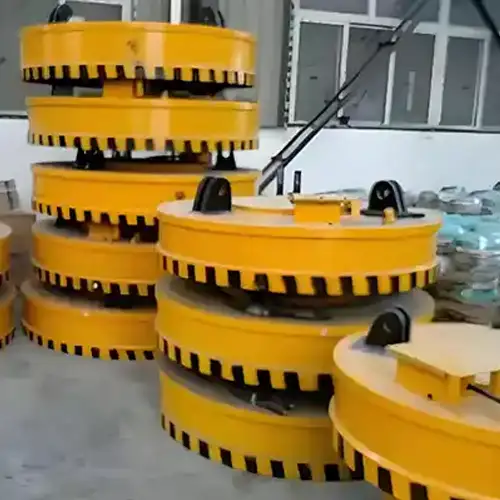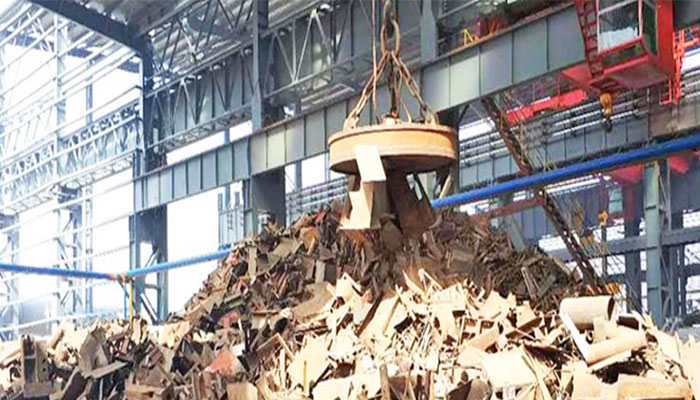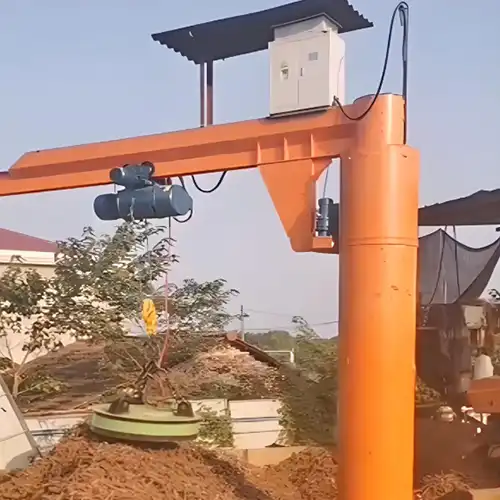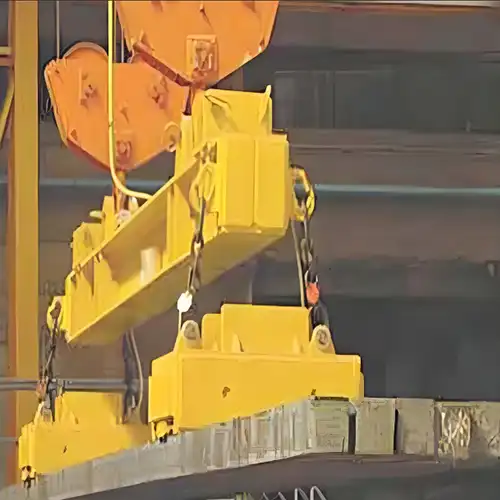Select the Right Electromagnet for Your EOT Crane & Gantry Crane
A guide to choosing electromagnets based on load type, crane specs, safety, and efficiency for overhead and gantry cranes. Get your electromagnet crane!
Category: Featured
Your Trusted Electromagnetic Overhead Crane Manufacturer & Supplier
How to Select the Right Electromagnet for Your Overhead Crane & Gantry Crane
Why Choosing the Right Electromagnet Matters
Electromagnets are powerful tools. When matched correctly to the job, they make lifting steel easier, faster, and safer. But choosing the wrong one can lead to poor performance, safety risks, and wasted investment.
If you're using an overhead crane to lift metal loads—like bundles of steel bars, plates, billets, or scrap—your magnet matters. It needs to fit the load type, size, and weight. It also has to work well with your crane setup and handle the working environment.
That's why selecting the right electromagnet is not something to guess.
Where Electromagnets Are Commonly Used
You'll see these magnets in many industries. Here are some of the main ones:
- Steel mills – for handling billets, slabs, and rebar.
- Scrap yards – for moving heavy, irregular scrap metal.
- Ports – loading and unloading steel materials quickly.
- Fabrication workshops – lifting steel plates and parts during production.
In each place, the needs are different. So the magnet has to be chosen based on real working conditions.
What This Guide Will Help You Do
This guide will walk you through how to choose the right electromagnet for your overhead crane.
You'll learn:
- What to consider for different types of loads.
- How to match the magnet to your crane.
- What common mistakes to avoid.
- And a few tips on customization to get the most value.
Whether you're an electromagentic crane buyer, engineer, or project manager, this guide is here to help you make a smart, clear choice.Ready to find the right magnet? Let's get started.
Key Factors in Electromagnet Selection
Load Type
Different loads need different magnets. The shape and surface of the material affect how well the magnet can hold it.
Common types of loads include:
- Rebar bundles – usually tied in rounds or squares, need wide-surface magnets.
- Steel plates – flat and thin, need full surface contact.
- Billets or square bars – solid and heavy, often stacked in rows.
- Scrap steel – irregular and dirty, needs a rugged magnet with strong grip.
Knowing your load type is always step one.
Load Size and Shape
Size matters. So does shape. Long plates or wide bundles may need more than one magnet to balance the weight.
Think about:
- Length and width of steel plates.
- Bundle diameter for rebar.
- Row layout for billets or bars.
The magnet has to cover enough surface to hold the load safely and evenly.
Load Weight Per Lift
Your crane might lift 20 tons, but that doesn't mean every load weighs that much. Still, you should know how much weight you're lifting at once.
Ask yourself:
- How many pieces are lifted in one go?
- What's the total weight of that batch?
- Are you lifting the same weight every time?
This helps you match the lifting force of the magnet to the real job.
Working Environment
Where you use the magnet affects how it performs. Harsh conditions may require special magnet design.
Things to consider:
- Indoor or outdoor use.
- High temperatures near furnaces.
- Dusty or oily surfaces.
- Rain or humidity if used outside.
You might need high-temperature or waterproof magnets in some cases.
Lifting Frequency and Duty Cycle
How often you lift also matters. If your crane is working all day, the magnet needs to handle that level of use.
Look at:
- Lifting frequency – how many times per hour?
- On/off time – magnets need cool-down if used too much.
- Duty cycle – this tells you how long the magnet can work safely in one cycle.
Heavy-duty use? You'll need magnets with a high-duty class.
Overhead Crane Specifications
Finally, don't forget your crane itself. The magnet must match the crane's limits and layout.
Check:
- Lifting capacity – magnet + load should not exceed it.
- Span and hook spacing – affects the design of the lifting beam.
- Power supply – make sure it's compatible with the magnet system.
The magnet is part of the system, not a standalone tool.
Electromagnets for Handling Different Types of Loads
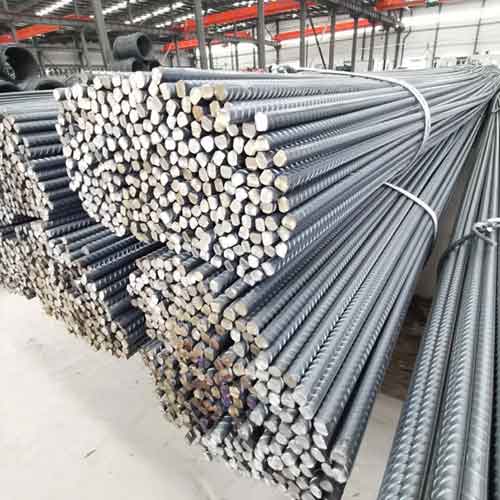
For Rebar (Deformed Bar) Bundles Handling
Rebar bundles are one of the most common steel products lifted by overhead cranes in steel mills and construction supply yards. They are round, tied in groups, and often stacked close together. To lift them efficiently, the magnet system must be carefully selected.
Key Things to Consider
You can't just go by the total weight. Other details matter too, like how the bars are bundled and how many you lift at once.
- Bundle diameter – thicker bundles need a wider magnet face for better grip.
- Number of bundles per lift – more bundles mean more weight and a longer lifting beam.
- Total lifting weight – always confirm the max load per lift, not just per piece.
Best Type of Electromagnet for Rebar
For rebar, rectangular electromagnets are the top choice. They give more surface contact and help prevent slippage, especially with smooth or slightly oily surfaces.
- Good surface area for gripping round or uneven bundles.
- Can be installed in pairs or sets on a lifting beam.
- Work well for lifting long, bundled loads.
Use Adjustable or Modular Lifting Beams
Rebar bundles vary in size from batch to batch. That's why using a beam that can adjust the magnet spacing is helpful.
- Modular beams allow magnets to slide and lock into different positions.
- Adjustable beams can handle short and long bundles with the same setup.
- Makes your crane more flexible for future jobs.
Make Sure the System Matches Your Crane
The full lifting system—including magnets, beam, and cables—must stay within your crane's rated capacity.
- Always calculate the combined weight of rebar and magnets.
- Keep beam length within the crane's working area.
- Use proper cable reels or festoon systems to manage magnet wiring.
In short, lifting rebar is all about balance—between magnet strength, beam design, and bundle layout. Getting this right means faster, safer handling and less wear on your equipment.
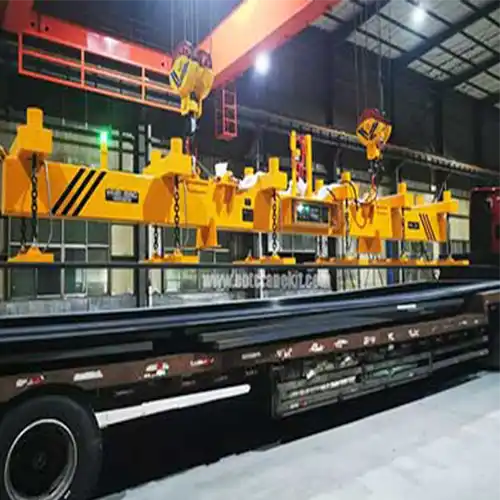
Steel plates can be tricky to handle. They are flat, often large, and sometimes thin. The right magnet setup makes a big difference in speed and safety.
What to Look At First
Before choosing magnets, check the plate details:
- Thickness – thin plates need more gentle handling, thicker ones need more lifting force.
- Width and length – large plates may require multiple magnets.
- Surface condition – oily or rusty plates affect magnet performance.
Also, decide if you're lifting one plate at a time or several together.
Recommended Magnet Type
Flat, rectangular electromagnets are the go-to option for steel plates. They provide strong, even holding power across a flat surface.
- Ideal for creating good surface contact.
- High magnetic penetration for thick or slightly uneven plates.
- Can lift single or stacked plates depending on strength.
Beam and Magnet Layout
For long or wide plates, don't rely on just one magnet. Use a spreader beam with multiple magnets placed along the length.
- Two to four magnets for mid-size plates.
- Six or more for wide, heavy-duty loads.
- The spreader beam helps balance the load and prevents bending.
Other Considerations
Steel plates can stick together. That can be a problem when you only want to lift one. Also, some customers require the plates to be fully demagnetized before delivery.
- Demagnetization units may be needed in some workshops.
- Choose magnets with a proper quick-release function.
- Use air gaps or spacers between plates to make separation easier.
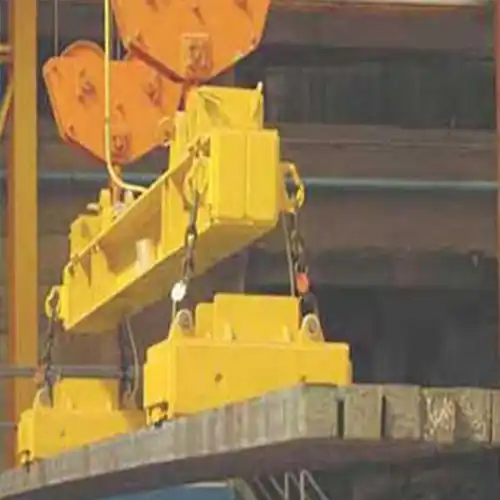
For Billets / Square Bars / Slabs Handling
Billets are heavy, solid, and often arranged side by side in rows. They require strong, focused magnetic force—and a well-designed lifting beam.
Important Factors
When selecting magnets for billets or square bars, consider:
- Billet size – width, height, and length.
- Number of billets per lift – usually picked in rows.
- Stacking method – tightly packed or spaced?
Each of these affects the magnet's size and how many you need.
Best Magnet Type
The MW22 series electromagnets are commonly used for lifting billets. They offer deep magnetic penetration and strong holding force.
- Suitable for hot and cold billets.
- Reliable in harsh steel mill environments.
- Available in different sizes for flexible setup.
Custom Beam Design
A standard beam usually won't do the job here. You'll need a custom lifting beam to match the billet arrangement.
- Magnet layout should match the spacing of the billets.
- Beam must be strong enough to support total load weight.
- Length and width of the beam depend on how many billets you lift per operation.
Lifting Features
Synchronous lifting and easy release make the process safer and faster.
- All magnets should lift and release at the same time.
- Quick-release control helps drop billets smoothly.
- Backup systems are often included in case of power failure.
Handling billets and plates is very different from handling scrap or rebar.
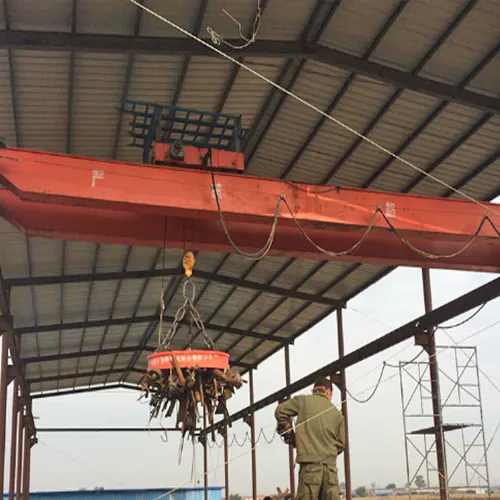
Scrap steel comes in all shapes and sizes. It's usually dirty, irregular, and can be heavy. Handling scrap requires a magnet that's tough and reliable.
What Makes Scrap Special
Unlike steel plates or billets, scrap is unpredictable.
Here are the main challenges:
- Bulk and irregular shapes – no two pieces are the same.
- Variable weight – one piece might be light, another heavy.
- Dirt, oil, and rust – scrap often comes with debris that reduces magnet performance.
Best Magnet Type for Scrap
Circular scrap-handling magnets are perfect for this job.
They're designed to handle all kinds of scrap, from thin sheets to large, heavy pieces.
- Robust and heavy-duty – built to lift big, bulky loads.
- High lifting capacity – even when the load is irregular.
- Shock-resistant design – can handle rough environments and occasional impacts.
Additional Features for Scrap Handling
If you're dealing with high-volume scrap, consider magnets with extra features for efficiency and reliability.
- High-duty cycle magnets – they're built to handle continuous use.
- Battery backup systems – in case of power loss, the magnet still works.
- Magnet generator systems – these provide power directly from the crane.
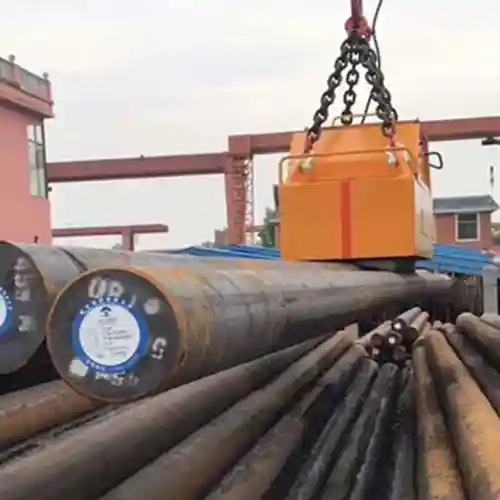
For Coils or Round Steel
Coils and round steel are not easy to lift with magnets. Because of their shape, magnets don't have much surface contact.
Why Coils Are Tricky
- Minimal contact surface – the curved surface of coils reduces grip.
- Weight distribution – coils are often heavy but hard to secure.
Magnet Solutions for Coils
Although magnets aren't the perfect fit, there are ways to make it work.
- Arc-shaped surface magnets – these are designed to match the coil's curvature.
- Mechanical clamps – combine magnets and clamps for a secure grip on round steel.
- Hybrid solutions – using both magnets and clamps allows you to handle coils effectively.
Special Considerations for Coils
When handling coils, you'll need to focus on balance and control.
- Careful weight distribution – ensure the coil is evenly supported.
- Anti-slip designs – prevent the coil from shifting or falling during lifting.
Handling scrap and coils is about finding the right balance between magnet power and design.
Customization Options
Choosing the right electromagnet isn't just about matching it to your load.
Customization can enhance performance, safety, and efficiency based on your unique needs.
Coil Voltage and Duty Class
The magnet's coil voltage and duty class determine how much load it can handle and for how long.
These are crucial when you know the workload will be heavy and continuous.
Coil voltage – Common options are DC 220V, but always check what your system requires.
Duty class – This refers to how much time the magnet can work before needing a cool-down period:
- 60% ED – suited for moderate use.
- 75% ED – for frequent use.
- 100% ED – continuous, heavy-duty use with no rest period.
The right combination of voltage and duty class ensures that the magnet works efficiently without overheating or damaging the system.
Waterproofing, High-Temperature, or Explosion-Proof Designs
For tough environments, customization becomes key.
Your magnet may need protection against the elements or extreme conditions.
- Waterproofing – Essential if you're using the magnet outside or in wet areas.
- High-temperature design – For environments where heat is a factor, like steel mills or foundries.
- Explosion-proof – For use in areas where flammable materials or gases are present.
These special designs prevent damage and ensure safe, long-lasting performance in harsh conditions.
Cable Reels or Festoon System Integration
Proper wiring management is critical for safe and efficient operation.
There are a couple of options for integrating the electrical system with your crane:
- Cable reels – These roll up the cables automatically, making sure they don't drag or get tangled.
- Festoon system – A more stationary solution where cables hang in a track and move with the crane.
Both options ensure the cables stay organized, protected, and easy to maintain.
Power Loss Protection and Magnet Control Systems
In case of a power failure or malfunction, you don't want the magnet to become a hazard.
- Power loss protection – Prevents the magnet from releasing the load when there's an electrical failure.
- Magnet control systems – Advanced systems allow you to monitor and control magnet functions from the crane cabin. You can adjust strength, timing, and safety features easily.
These systems help ensure safety and reliability, even in emergencies.
Customizing your electromagnet setup isn't just about making it work—it's about making it work better. With the right voltage, protection features, and control systems, your magnet setup will be ready for any job, no matter how tough.
Matching the Magnet System to Your Crane
Once you've selected the right magnet, it's time to make sure it works seamlessly with your crane. Matching the magnet system to your crane is crucial for safe and efficient lifting.
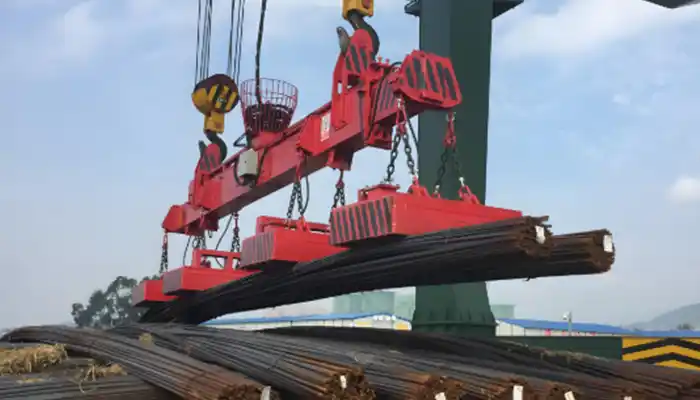
Electromagnetic gantry crane for outdoor steel loads handling
Verifying Lifting Capacity with Full Magnet Load
Before installing the magnet, confirm that your crane can handle the total load with the magnet attached.
The combined weight of the load and magnet shouldn't exceed your crane's rated lifting capacity.
- Calculate the total load: Magnet + material.
- Ensure your crane's lifting capacity matches or exceeds the combined weight.
- Always factor in extra weight for safety—don't push the limits.
Checking Compatibility with Crane Hook, Lifting Beam, and Control Systems
The magnet system needs to be compatible with your crane's structure and control system.
Here's what to check:
- Crane hook – Make sure the hook can securely attach to the lifting beam and magnet.
- Lifting beam – The beam should be strong enough to hold the magnet and distribute the load evenly.
- Control systems – Verify that the magnet control system integrates smoothly with the crane's existing controls (manual or automatic).
Ensuring compatibility here prevents mechanical failures and makes operation smoother.
Ensuring Safety Features Are in Place
Safety should always be a top priority.
Certain features ensure that your magnet system works safely, even in emergencies.
- Backup battery systems – Ensure there's a backup in case of power loss.
- Emergency release system – A quick-release function in case of an emergency or system failure.
- Load monitoring systems – To avoid overloading the crane or magnet.
These features reduce the risk of accidents and ensure your operations are always safe.
Integration with Wireless Remote or Operator Cabin
For ease of operation, many cranes now include wireless remote control or integrated operator cabin controls.
These allow operators to manage the magnet system more effectively.
- Wireless remote – Gives the operator full control from a distance.
- Operator cabin – Integration with the crane's cabin control system allows seamless control of magnet strength, lifting speed, and release.
This integration ensures greater precision, flexibility, and ease of use in day-to-day operations.
Matching your magnet system to your crane is all about ensuring it works safely and efficiently.
Check the compatibility, safety features, and integration carefully to get the most out of your equipment.
With the right setup, your crane and magnet will be ready to handle any job.
Common Mistakes to Avoid
Choosing the right electromagnet isn't always straightforward, and mistakes can lead to safety issues or inefficiencies.
Here are some common errors to watch out for when selecting and using magnets for your crane.
Overlooking Load Distribution and Lifting Point Alignment
When lifting a load, improper distribution can lead to imbalance and dangerous situations.
It's important to make sure the load is evenly distributed, and the lifting points are aligned properly.
- Check load balance – If the magnet doesn't lift the load evenly, it can cause the crane to tilt or the material to fall.
- Align lifting points – Misalignment between the magnet and load can lead to inefficient handling or damage.
Always check that the load is evenly distributed and aligned with the lifting beam before operation.
Ignoring Magnet Weight in Crane Load Calculations
It's easy to forget that the magnet itself adds weight to the load, but this can throw off your crane's capacity.
- Consider magnet weight – The magnet adds to the total load, which affects how much weight the crane can safely lift.
- Include the magnet in calculations – Make sure to factor in the magnet weight when determining the total load for each lift.
This step ensures your crane operates within safe limits and avoids overloading.
Choosing Magnets Without Considering Temperature or Surface Condition of the Material
Different materials and environments require different magnet types.
Ignoring the material's temperature or surface condition can result in poor performance or damage.
- Temperature considerations – Magnets may lose strength at high temperatures. For hot materials like steel billets, make sure you choose a magnet designed for high-heat environments.
- Surface condition – Rust, oil, or dirt can reduce the magnet's efficiency. Always check the surface condition of the material being lifted and select the magnet accordingly.
Selecting magnets based on the material's characteristics ensures maximum lifting efficiency and safety.
Avoiding these common mistakes will help you get the most out of your crane and magnet system.
By double-checking load distribution, magnet weight, and material conditions, you can prevent accidents, reduce wear on your equipment, and keep operations running smoothly.
Conclusion
Choosing the right electromagnet for your overhead crane can make a huge difference in safety, efficiency, and cost.
To sum up, here are the key steps to follow when selecting a magnet system:
Key Selection Steps:
- Understand the load type – Different materials require different magnet setups (e.g., rebar, plates, billets).
- Check the load size, shape, and weight – Ensure your magnet is sized correctly for the job.
- Consider the working environment – Outdoor or high-temperature environments need specialized magnets.
- Match the magnet with your crane's specifications – Verify lifting capacity, hook compatibility, and control system integration.
- Customize features for safety and ease of use – Backup systems, remote controls, and extra safety features go a long way.
Work with Experienced Manufacturers
Choosing the right magnet system can be complex, and it's important to work with experienced magnet and crane manufacturers.
They can guide you through the selection process, ensure compatibility, and customize the system for your specific needs.
- Experienced manufacturers understand the details of load handling and can provide expert recommendations.
- They offer custom solutions that fit both your crane and your lifting requirements.
Encourage Site Assessment and Load Testing
Before finalizing your magnet choice, conduct a site assessment to fully understand the working conditions.
Also, perform load testing to verify that the selected system handles real-world lifting without issue.
- A site visit ensures that your crane and magnet system will work as expected in your environment.
- Load testing gives you confidence that the system is safe and effective before full operation.
By following these steps and working with trusted experts, you'll ensure a smooth and efficient lifting operation. Choosing the right electromagnet is a key investment that pays off in safety, performance, and reliability.
Bonus: Quick Reference Chart
Use this quick reference chart to easily match load types with the best magnet type and key considerations for your crane system. It'll save you time when making decisions and help you avoid common pitfalls.
| Load Type | Magnet Type | Key Considerations |
|---|---|---|
| Rebar Bundles | Rectangular Magnet | Bundle size, number of lifts, load distribution |
| Steel Plates | Rectangular Magnet | Plate thickness, need for demagnetization, width/length |
| Billets / Slabs | MW22 Magnet | Row layout, spacing between billets, handling speed |
| Scrap Steel | Circular Magnet | Durability, handling dust/debris, power backup for continuous operation |
| Steel Coils | Hybrid or Custom | Curved surface matching, anti-slip features, use of clamps |
This chart can help you quickly identify the right magnet for your specific lifting requirements. With this, you'll be ready to make informed decisions, ensuring safety and efficiency in your operations.Contact us today to get your customized electromagnetic chuck and electromagnetic beam spreader for your overhead crane and gantry crane for steel mill and scrap yards!
Related Products
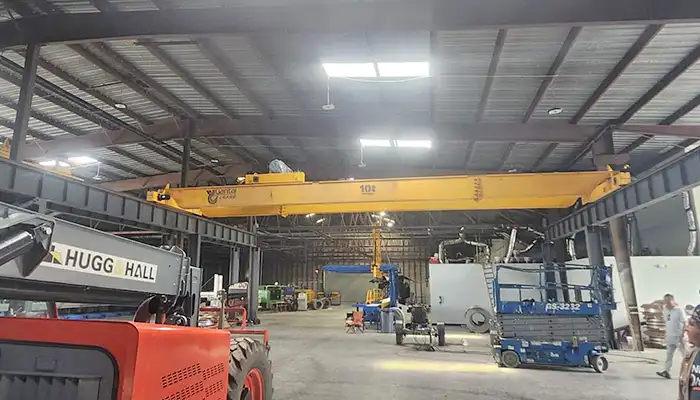
Affordable 10 ton double girder overhead crane with CD/MD hoist trolley, built for U.S. standards, ideal for construction and industrial lifting
Free consultation to Confirm Parameters & Specifications and Get
Latest Crane Price & Crane Rate.
- Types of overhead cranes : _______?
- Optional: Overhead travelling crane, goliath gantry crane,Slewing jib crane, Single girder or double girder crane,small portable crane or kbk crane, etc.
- Capacity of overhead crane: _______?
- Optional: 0.25ton, 0.5 ton, 1 ton, 2 ton, 3ton, 5 ton, 10 ton,15ton, 20ton, 25 ton, 30ton,35ton, up to 550ton, etc.
- Crane span & lifting height : _______?
- Crane travelling length : _____?
- Control of overhead crane:_______?
- Optional: pendant/ remote/cabin control
- Voltage supply of overhead crane:_____?
- Eg,: 380V50/60HZ,3Phase or others,etc.
- Application/usage of crane:_______?
- Eg,: Steel mill, ,injection mold, cement,stone, concrete,granite, general manufacturing, etc.
Just leave a message via the contact form and our hoist and crane engineer will contact you with in 24working hours.
Get In Touch
